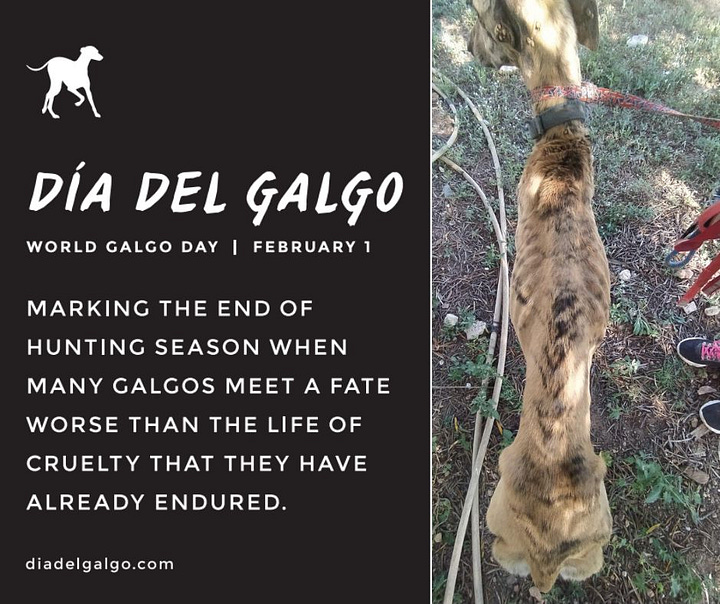Against the cruel killing of Spanish hunting dogs
February 1 is World Galgo Day. Appeal to humanity.

In Spain, it is not only bullfighting that is still a tradition. Greyhound races are also held extensively here. The animals are mercilessly exploited by their owners. And sorted out at the end. After the hunting season in February, tens of thousands of the native galgos die an agonizing death every year.
And then there are the hangings. Dogs who have performed well in competition but are no longer in top form may be hanged high from a tree—a relatively quick death. Those who have embarrassed their galgueros by racing poorly may also be hanged, but low to the ground so their paws barely touch. Their desperate scrabbling for footing as they slowly choke to death is called “piano playing,”
Abigail Christman, GRIN
This is how Abigail Christman, founder of the Galgo Rescue International Network (GRIN) based in Colorado, USA, describes a spectacle that happens thousands of times every February in Spain. When the hunting season ends in January, the hunters get rid of all the dogs they don't want to feed for the seven months until the next season. According to animal rights activists, at least 60,000 galgos meet an agonizing end in this way every year. Galgos look like greyhounds and are a very old breed of hunting dog that was once bred exclusively by Spanish aristocrats. Nowadays, they are just a means to an end for their owners, the galgueros. An object that they "use" as they see fit.
Animal rights activists have set an example against this medieval attitude and the bestial sorting out with World Galgo Day on February 1st. For years, they have also been taking to the streets at the end of the hunting season - and not just in Spain. In Germany, Austria and Switzerland, France, Poland and London, animal rights activists also protest in front of Spanish embassies or march through city centers on "Galgo Marches". Dates here.


The article in National Geographic, from which the opening sequence about the agonizing ritual of "playing the piano" is taken, describes the situation in Spain and the background perfectly. The text first appeared in 2016. A lot has changed since then. And not in the dogs' favor. While National Geographic was still talking about new nationwide laws against cruelty to animals and provinces and localities that had passed similar regulations, the Spanish parliament turned the clocks back again in 2023. According to an amendment to the Animal Welfare Act, which came into force on September 29, 2023 (see my article), galgos and other hunting dogs are now officially considered farm animals and are exempt from animal welfare nationwide. Their owners are now allowed to torture and kill the dogs with the blessing of politicians. And the often illiterate hunters do this with abandon, because they believe that the longer the dogs suffer, the more successful the following hunting season will be. So the men beat the animals to death with stones, throw them into pits and wells to drown them, bury or burn them alive, burn them with acid.
And new Galgos are bred every year... The hunters breed them themselves to use the dogs for hare hunting and greyhound racing between September and January. The animals are kept in the most miserable conditions. "We've had galgueros that have had 70, 120 galgos, living on crisps and bread and eating each other when they die," Tina Solera, the founder of the rescue organization Galgos del Sol, based in Murcia in Southern Spain, told National Geographic. The Podenco, another Spanish greyhound breed, is maltreated in the same way:
Since there is a belief among galgueros that dogs hunt better when they are hungry, the podenco is usually starved or fed and watered just enough to keep them alive. After hunting season ends or when a podenco is no longer useful, they face much the same fate as the galgo. They are sometimes hung or poisoned, but more often they are driven to a remote location and abandoned, sometimes being beaten, having legs broken or in one known case, having their eyes gouged out so they cannot find their way home.
Galgo Rescue International Network, GRIN
How is such cruelty to animals possible in a member state of the European Union? A German MEP told me that this is a matter for the national state. While bananas are standardized according to curvature and length throughout the EU, and more and more areas of life tend to be regulated centrally by Brussels, animal cruelty is supposed to be a national matter in which the EU is not allowed to interfere? Do MEPs really have no influence? Of the 21 Spanish MEPs from different parties that I asked for their opinion, none of them thought it was worth answering.
However, there are two rays of hope for the animal rights activists: the vote in the Spanish parliament to exclude hunting dogs from animal welfare was very close, with 174 votes to 167. With a majority of just seven votes. The same number of MPs abstained. And: The once only Spanish MEP in the European Parliament’s Intergroup on the Welfare of Animals, Ernest Urtasun, is now Minister of Culture in Madrid- and in this role is also responsible for hunting.
This text was first published in German on my website.



